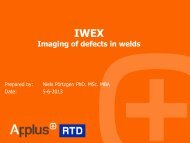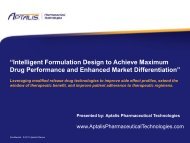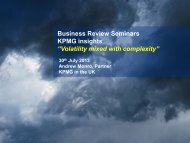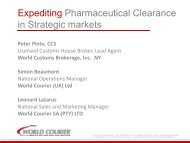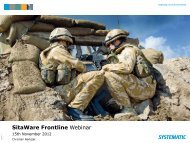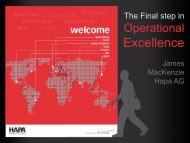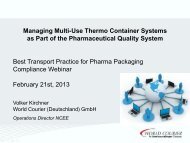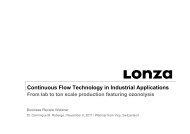Comparability Studies: The Key to a Biosimilar's Success - Business ...
Comparability Studies: The Key to a Biosimilar's Success - Business ...
Comparability Studies: The Key to a Biosimilar's Success - Business ...
You also want an ePaper? Increase the reach of your titles
YUMPU automatically turns print PDFs into web optimized ePapers that Google loves.
<strong>Comparability</strong> <strong>Studies</strong>:<strong>The</strong> <strong>Key</strong> <strong>to</strong> a <strong>Biosimilar's</strong> <strong>Success</strong>Raymond Kaiser, PhDGlobal Vice PresidentBioPharmaceutical CMC SolutionsCovance
Presentation OutlineWhat is “Biosimilarity”Global Regula<strong>to</strong>ry CMC Expectations<strong>Comparability</strong> ExpectationsAnalytical Approaches <strong>to</strong> comparability“Real World” observationsQ&A2
What is a Biosimilar?Biosimilars are follow-on biologics New versions of innova<strong>to</strong>rbiopharmaceutical products,following patent expiry<strong>The</strong> very nature of a biologic means It is practically impossible for two different manufacturers <strong>to</strong> producetwo identical biopharmaceuticals if identical host expressionsystems, processes and equivalent technologies are not used This has <strong>to</strong> be demonstrated in an extensive comparability program3
Biosimilar or Biosimilarity means:<strong>The</strong> biological product is highly similar<strong>to</strong> the reference product notwithstanding minordifferences in clinically inactive components<strong>The</strong>re are no clinically meaningful differencesbetween the biological product and the referenceproduct in terms of the safety, purity, and potency ofthe product4
Global Regula<strong>to</strong>ry LandscapeEMA (<strong>The</strong> European Medicines Agency)Established EMA approval pathway:14 biosimilars approved* within the product classes of:‣ human growth hormone‣ granulocyte colony-stimulating fac<strong>to</strong>r (G-CSF)‣ erythropoietinUS FDABiologics Price and Innovation Act passed in 2010‣ Empowers FDA <strong>to</strong> develop standards <strong>to</strong> evaluate and approve biosimilarsFDA February 2012 draft guidance documents‣ Risk-based “<strong>to</strong>tality-of-the-evidence” approachHealth CanadaGuidance came out in 2010JapanGuideline came out in 2009WHOGuideline document came out in 2009ROWArgentina, Australia (amending), Brazil, Jordan, Korea, Malaysia, Saudi Arabia, Singapore,Taiwan, Turkey, Venezuela – Guidelines availableColombia, Cuba, India, Mexico, South Africa, and Thailand – Draft Guidelines availableBiosimilar Regula<strong>to</strong>ry Guidance documents and discussions are on-goingand expanding globally.5
Regula<strong>to</strong>ry Environment - EUEstablished EMA approval pathway14 biosimilars approved within the product classes of:‣ Human growth hormone‣ Granulocyte colony-stimulating fac<strong>to</strong>r (G-CSF)‣ Erythropoietin<strong>Key</strong> EMA guidance documents“Overarching” guideline on similar biological medicinal products‣ From 2005, currently being updatedGuideline on similar biological medicinal products containing biotechnologyderivedproteins as active substances: quality issues‣ From 2005Guideline on similar biological medicinal products containing biotechnologyderivedproteins as active substances: nonclinical and clinical issues‣ From 2005, currently being updated <strong>to</strong> incorporate risk-related approaches6
Regula<strong>to</strong>ry Environment – USFDA approval pathway establishedBiologics Price and Innovation Act passed in 2010 empowersFDA <strong>to</strong> develop standards <strong>to</strong> evaluate and approve biosimilarsFDA February 2012 draft guidance documents Scientific Considerations in Demonstrating Biosimilarity <strong>to</strong> aReference Product- Risk-based “<strong>to</strong>tality-of-the-evidence” approach Quality Considerations in Demonstrating Biosimilarity <strong>to</strong> a Reference ProteinProduct- Overview of analytical fac<strong>to</strong>rs <strong>to</strong> consider, includes analytical, physicochemicaland biological characterization Biosimilars: Questions and Answers Regarding Implementation of the BiologicsPrice Competition and Innovation Act of 2009- Provides answers <strong>to</strong> common questions that may arise in the early stagesof product development7
General Requirements of FDA GuidanceA 351(k) application must include information demonstratingbiosimilarity based on data derived from:‣ Analytical studies demonstrating that the biological product is“highly similar” <strong>to</strong> the reference product notwithstanding minordifferences in clinically inactive components‣ Animal studies (including the assessment of <strong>to</strong>xicity)‣ A clinical study or studies (including the assessment ofimmunogenicity and pharmacokinetics (PK) orpharmacodynamics (PD)) that are sufficient <strong>to</strong> demonstratesafety, purity, and potency in 1 or more appropriate conditions ofuse for which the reference product is licensedFDA may determine, at its discretion, that an elementdescribed above is unnecessary in a 351(k) application8
Regula<strong>to</strong>ry Environment - ICH RegionsHow do the requirements compare? US, EU and Japan all require comparability with reference product Reference product must be registered under the Regula<strong>to</strong>ry jurisdiction‣ In EU this is law‣ FDA will consider non-US registered reference product with studies <strong>to</strong> bridge <strong>to</strong> USreference‣ Japan requires Japanese registered product Early engagement with Regula<strong>to</strong>ry Authority is vital Extrapolation of indications will be considered At least one Phase III comparable efficacy study (usually with equivalence design) isrequired for licence9
Regula<strong>to</strong>ry <strong>Comparability</strong> PackageExtensive Analytical & In Vitro Extensive analytical characterization versus reference product(s) If mAb‣ specificity & affinity <strong>to</strong> epi<strong>to</strong>pe‣ potency using CDC, ADCC &/or functional in vitro cell-based assaysLimited in vivo Nonclinical PK/PD studies, Toxicology (SD/MD), and Immunogenicity studies(requirement for nonhuman primates?)Limited Clinical Phase I‣ comparability of PK/PD & Immunogenicity in volunteers or patients atreference dose and regimen for targeted indications Phase III‣ comparability for safety and efficacy (single pivotal) based on PK/PD,surrogate endpoints and clinical outcomesExtensive Post-Approval REMS and pharmacovigilance planning including patient registry(ies) forassessment of incidence of specific safety issues10
Development ChallengesRegula<strong>to</strong>ry, manufacturing and marketing complexitiesBiosimilar must be highly similar <strong>to</strong> innova<strong>to</strong>r biologic, which can bedifficult <strong>to</strong> demonstrate as all data for innova<strong>to</strong>r will be lackingA comparability exercise has <strong>to</strong> be followed with the innova<strong>to</strong>rproduct at all levels of product developmentPhysico-chemical characterizationBiological activityPreclinical in vivo comparabilityPhase I PK and safetyPhase III efficacy and safetyIt’s all about comparability11
Biosimilarity?• How close do the proposedbiosimilar products (figures B-E) compare <strong>to</strong> the referenceproduct (figure A)?• Advances in current state-ofthe-artanalytical methodsenhance the likelihood that aproduct will be highly similar<strong>to</strong> another product by bettertargeting the original product'sphysicochemical andfunctional properties‘Biosimilar Biological Product’ Webinar, Rachel Sherman, FDA, 15FEB201212
FDA View‘Biosimilar Biological Product’ Webinar, Rachel Sherman, FDA, 15FEB201213
Biosimilars must be Systematically Engineered<strong>to</strong> Match the Reference ProductMark McCamish, Novartis, International Conference on Drug Development, Austin TX,29FEB201214
CharacterizationComprehensive Characterization Physicochemical as well as biological Multiple batches from innova<strong>to</strong>r spanning a number ofyears Understand innova<strong>to</strong>r variability‣ Specification changes over life of product‣ No label change15
Amount ofCharacterisationBiosimilars at CovanceYear on year doubling of analytical demand for Biosimilars since 2008Upgraded Protein Chemistry techniqueswith additional characterization <strong>to</strong> demonstrate comparability orunderstand differencesMoved <strong>to</strong>ward higher defining analytics (e.g. UPLC, LC/MS)Compounds 1000 500 250 100 20 1DISCOVERYDRUG DEVELOPMENTCOMMERCIALIZATIONResearch Preclinical Phase I Phase II Ph. IIIa IIb Phase IVIND/CTA NDA /BLA ApprovalNBEBiosimilar16
Why More Characterization for Biosimilars?Client has <strong>to</strong> show high ‘similarity’ <strong>to</strong> Innova<strong>to</strong>r“Proving ‘highly similar’ <strong>to</strong> the reference product oftenrequired multiple iterations of process change andphysiochemical characterization”• Characterization of the Innova<strong>to</strong>r (beware literature!)• Characterization of the Biosimilar• Moni<strong>to</strong>r Manufacture‘Process is the product’• Moni<strong>to</strong>r changes in Innova<strong>to</strong>rAnalytical <strong>to</strong>ols for characterizing biopharmaceuticals and the implications for Biosimilars. S Berkowitz,J Mazzeo, G Jones, Nature review Vol 11, Jul 201217
Why More Characterization for Biosimilars?18
Protein Heterogeneity• Amino Acid Substitution• AA Misincorporation (e.g.METNLE)• N- and C-terminal mods• Mismatched S-S bonds• Folding• Truncation• Aggregation• Multimer Dissociation• Denaturation• Acetylation• Fatty acid acylation• Deamidation• Oxidation• Carbamylation• Carboxylation• Formylation• -Carboxyglutamylation• O-linked Glycosylation• N-linked Glycosylation• Methylation• Phosporylation• Sulphation• PEGylation• etc.19
Analytical Tools <strong>to</strong> Evaluate Protein Structure (subset)Protein FunctionalityAA Sequence andModificationsFoldingSubunit InteractionsHeterogeneity of size,charge, hydrophobicityGlycosylationPEGylation & isomersBioactivity, cellular andanimal bioassaysAggregationProteolysisImpuritiesAnalytical TechniqueMass Spectrometry (MS), peptide mapping, Edman Sequenceanalysis, chroma<strong>to</strong>graphic separationsS-S bonding, calorimetry, HDX and Ion mobility MS, NMR, CD,FT & Raman spectroscopy, fluorescence, chroma<strong>to</strong>graphyChroma<strong>to</strong>graphy, ion mobility MSChroma<strong>to</strong>graphy, gel & capillary electrophoresis, light scatterAnion exchange, enzymatic digestion, peptide mapping, CE, MSChroma<strong>to</strong>graphy, peptide mappingLigand & recep<strong>to</strong>r binding (ELISA, SPR), signal transductionAnalytical ultracentrifugation, size-exclusion chroma<strong>to</strong>graphy,field flow fractionation, light scatter, microscopyElectrophoresis, chroma<strong>to</strong>graphy, MSChroma<strong>to</strong>graphy, proteomics, immunoassays, PCR20
Mass SpectrometryIntact mass, comparison of Glycan variants. <strong>The</strong>difference in 56Da attributed <strong>to</strong> incorrect amino acidsequence21
RU80Hormone Recep<strong>to</strong>r Binding by BiacoreRU80707060605050Resp. Diff.4030DS BiosimilarResp. Diff.4030DP Biosimilar2020101000-100 50 100 150 200 250 300 350Times-100 50 100 150 200 250 300 350TimesResp. Diff.RU9070503010Innova<strong>to</strong>rDrug SubstanceSample Lot No. KD (nM) % Difference1 301Biosimilar 2 3993 4124.401 415Innova<strong>to</strong>r 2 3503 397Drug ProductSample Lot No. KD (nM) % Difference1 202Biosimilar 2 1723 118-1.641 138Innova<strong>to</strong>r 2 1883 158-100 50 100 150 200 250 300 350Times22
Absorbance7.4197.524Main - 7.6137.8087.9918.145Finding the Differences by C-IEF0.240.220.200.180.160.140.120.10Blue - BiosimilarBlack - Innova<strong>to</strong>r0.080.060.040.020.006.60 6.80 7.00 7.20 7.40 7.60 7.80 8.00 8.20 8.40 8.60 8.80 9.00 9.20 9.40MinutesSampleName: SB03iCE12-ADM3011P1 5C Lyo Date Acquired: 15-Dec-2010 20:16:15 -05:00 Result Id: 1581SampleName: SB03iCE08-WL00039785 5C Lyo Date Acquired: 15-Dec-2010 18:55:04 -05:00 Result Id: 158023
Absorbance7.1597.2497.3337.430Main - 7.5337.6597.731Carboxypeptidase Treatment0.280.260.240.220.200.180.160.140.120.100.080.06Blue - Innova<strong>to</strong>rBlack - Biosimilar0.040.020.00-0.026.40 6.60 6.80 7.00 7.20 7.40 7.60 7.80 8.00 8.20 8.40 8.60 8.80 9.00 9.20 9.40 9.60MinutesSampleName: SB07 iCE 05-WL00039785 9M RecoP3 Date Acquired: 21-Jul-2011 18:53:27 -05:00 Result Id: 4011SampleName: SB07 iCE 09-ADM30011P1 9M RecoP1 Date Acquired: 21-Jul-2011 20:34:30 -05:00 Result Id: 401724
Absorbance6.7986.9276.9967.1387.2657.3827.481Main - 7.5317.6037.7097.8057.9068.041Forced Degradation0.1300.1200.1100.1000.0900.0800.0700.060Blue - BiosimilarBlack - Innova<strong>to</strong>r0.0500.0400.0300.0200.0100.000-0.0106.00 6.20 6.40 6.60 6.80 7.00 7.20 7.40 7.60 7.80 8.00 8.20 8.40 8.60 8.80 9.00 9.20 9.40 9.60 9.80MinutesSampleName: SB09 iCE 12-ADM3001P1 30C Rec Date Acquired: 20-Sep-2011 21:19:46 -05:00 Result Id: 4716SampleName: SB10 iCE 13-WL00039785 30C Rec Date Acquired: 20-Sep-2011 21:27:34 -05:00 Result Id: 475825
Impact of Glycosylation?Blue- Innova<strong>to</strong>rBlack- Biosimilar26
AbsorbanceSimplify by De-sialylation?0.300.280.260.240.220.200.180.16Blue- Innova<strong>to</strong>rBlack- Biosimilar0.140.120.100.080.060.040.020.00-0.023.50 4.00 4.50 5.00 5.50 6.00 6.50 7.00 7.50 8.00 8.50 9.00 9.50Minutes27
EnergyN-Glycan Similarity2200.002000.00G0F1800.001600.001400.001200.00G1FG2FBlue- Innova<strong>to</strong>rBlack- Biosimilar1000.00Man5G1F’800.00600.00400.00G0G1’G1200.000.008.00 10.00 12.00 14.00 16.00 18.00 20.00 22.00 24.00 26.00 28.00 30.00Minutes28
Mass Spectrometry29
Peptide Map30
NOTE: Origina<strong>to</strong>rs make ‘biosimilars’ every time there is amanufacturing process changeAranesp ® (Darbepoetin-alfa)Mab<strong>The</strong>ra®/Rituxan® (Rituximab)Enbrel ® (Etanercept)Ref: Schiestl et al. Nat. Biotechnol. 2011; 29: 310-312(Sandoz)31
Characterization of Commercial Batches ofDarbepoetin alfa from the EUChange in isoform distribution between two sets of batches (expiry dateApril 2010 and September 2010)Schiestl et al. Nat. Biotechnol. 2011; 29: 310-31232
Characterization of Commercial BatchesMabthera®/Rituxan® (rituximab)•Shift in Glycosylation Profile and ADCC Potency• Differences/shift in glycosylation pattern results in different potency in cell-based assays• Product label remained unchanged –indicating comparable qualitySchiestl et al. Nat. Biotechnol. 2011; 29: 310-31233
Characterization of Commercial Batches of Enbrel• Shift in Glycosylation Profile• Differences/shift in glycosylation pattern• Product label remained unchanged –indicating comparable qualitySchiestl et al. Nat. Biotechnol. 2011; 29: 310-31234
Demonstrating <strong>Comparability</strong> in an Ideal World?Product heterogeneity is clearly unders<strong>to</strong>od, variants areeasily isolated and characterized Product variants and related impurities Process related impuritiesSmooth manufacturing scale up, no process changesMethods ready <strong>to</strong> demonstrate comparability withoutdevelopment. “One size fits all”Enough time and a ‘crystal ball’ <strong>to</strong> know what <strong>to</strong> look for35
What does This Look Like in the ‘Real World’?Biosimilars are “snowflakes”. No two are the sameIncomplete comparability characterizationExperience rapid time pressuresFinal formulation often undecidedManufacturing difficulties with scale upFast turn around in-process sample analysisRapid development and validation for ‘discriminating’ assaysNeed justification and risk assessment for observeddifferences36
Other ‘Real World’ Observations IIStress stability studies (w/ multiple time points) neededMultiple lots of reference product often used. Understandimpact of ref. product ‘shelf-life’ on results. Justify useReference product isolation procedure can impact results<strong>Comparability</strong> continues even after releaseGMPs apply for biosimilar product developmentMeet with BOHs as early as possible <strong>to</strong> discuss youranalytical control strategy
Other ‘Real World’ Observations IIIProtein analysis requires an ‘integrated’ set of analyticalmethodsEvaluate all domains and protein modificationsUse orthogonal analytical methods <strong>to</strong> confirm observationsand expectations.State-of-the-art techniques are expectedRealize each analytical method has strengths andweaknesses:Spectral methods measure averagesQualitative vs. quantitative?Variable sensitivityetc.38
SummaryBiosimilar regula<strong>to</strong>ry guidelines continue <strong>to</strong> evolveDemand for biosimilar CMC development continues <strong>to</strong> growDemonstrating comparability requires extensive analysispre- and post-clinically. Must completely characterizeinnova<strong>to</strong>r productWe are making progress linking some, but not all, biologicalproperties <strong>to</strong> critical quality attributes; therefore, Given a gradation of a biologics complexity, a one size fits allstrategy for biosimilars will not be possible39
Let us know how we can help you!DISCOVERYDEVELOPMENTCOMMERCIALIZATIONRESEARCH PRECLINICAL PHASE I PHASE IIIPHASE IVEfficacy Model Development/Biomarker DevelopmentImmunogenicity, PK, TKImmuno<strong>to</strong>xicity: CDC & ADCCTissue Cross ReactivityPharmacokinetics/ToxicityViral ClearanceProcess Development Support, Biomanufacturing Support, Biosafety TestingIn vivo/In vitro BiopotencyPhysicochem & Biological CharacterizationHealth Economics AssessmentSerum ProductionReimbursementClinical FeasibilityPhase I <strong>to</strong> Phase III Clinical TrialsClinical Development: Target PopulationClinical Development: Special PopulationsStability and ReleaseOutcomes/PE <strong>Studies</strong>Central Labs Data: Safety and GenotypingPost-Marketing CommitmentsMolecular Development (Program Management & Clinical)Regula<strong>to</strong>ry Strategy, EMA/FDA Documentation Prep & Meeting Attendance, CTA/IND/BLA Support and Submission40
Acknowledgments• Our many global clients who have challenged us withvarious Biosimilar products• Sian Estdale, Raymond Donninger, Ji Wu and the rest ofthe Covance team41
Thank you …. Questions?raymond.kaiser@covance.com42








